Hi! My name is Yuen Azu, and I am the 2022 Our World Underwater Scholarship Society (OWUSS) / American Academy of Underwater Sciences (AAUS) Dr. Lee H. Somers Scientific Diving Intern, hosted by the University of California, Davis Bodega Marine Laboratory. I’m an undergraduate at Amherst College working towards a Biology degree, and I got an amazing opportunity this year to learn how to dive for research purposes.
My story begins in mid-July. It was a foggy, cool morning when I arrived at the Bodega Marine Laboratory. Surrounded in state protected land, the laboratory entrance is landmarked by a solid group of trees fortifying the gate. I eeked at 15 miles per hour along the last stretch of road after punching in the gate code, keenly aware of my speed after reading the warning signs for wildlife crossings. Horseshoe cove was blanketed in a gradient of whiteness until the undulating water disappeared just beyond the headlands. I was tempted to step out of my car and walk along the shore for a quick scenic stop, but the entrance was closed off with NO ENTRY PERMITTED signs.
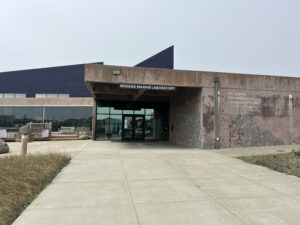
Entrance to the Bodega Marine Laboratory in Bodega Bay, California
I stepped out and pulled on a sweater. I had been warned about the mild temperatures of the coast but had naively thought that I could handle it Michigan-style. Still, it was the middle of summer and my brain was wired for heat at this time of year. Jason Herum, the Dive Safety Officer (DSO) for UC Davis and my day-to-day contact at the lab, was here to give me a private tour of the facility. He greeted me warmly outside, and we headed towards the main building. We had long phone conversations about the logistics of my internship over the past several months, and it was great to finally put a face to his voice. At a relaxed pace we made our way to the different wings of the building and walked over to other areas that I would be spending quite some time at, like the dive safety classroom, the dive locker, and the tank filling station. We also made a stop at the north-western edge of the property, a concrete and wood structure designated as the Diver Training Facility. Jason swung the heavy wooden door open and a blue, crystal-clear pool appeared on the other side. If it hadn’t been in the low 60s, I would have dipped my toes in the water without hesitation. We continued the outdoor tour to the edge of Horseshoe Cove, and Jason explained that typically access was restricted due to ongoing research, live feed cameras, and marine mammal pupping seasons. Hence the NO ENTRY PERMITTED signs.
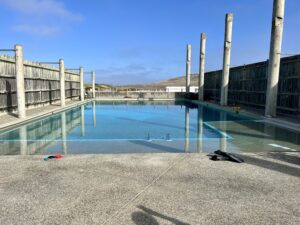
Diver training facility at Bodega Marine Laboratory
I had a couple of days to settle in before the first half of the Research Dive Techniques course would begin. I spent that time sightseeing the Bodega Head, mentally and literally prepping for an intensive week, and catching the 2022 Australasian Scholar, Millie Mannering, right before she headed out to her next adventure. Helping her out was 2019 DAN Intern Abbey Dias, who also happened to work at BML. It was only for a few hours that day, but I was excited to see two familiar faces before my internship officially began.
Sunday rolled around and marked the beginning of a whirlwind week full of lectures, pool time, and mild sunburns. I met the other five students and learned their stories leading them to this course, each at a different point in their lives–either in graduate school, in between school, or working. I also met the other instructors alongside Jason: Shelby Kawana, the Assistant Boating and Diving Safety Officer, John Harreld, the Volunteer Instructor and co-founder of the Sonoma Coast Historical and Undersea Nautical Research Society (SCHUNRS), and Brian Bennett, the DSO at both San Francisco State University and Sonoma State University.
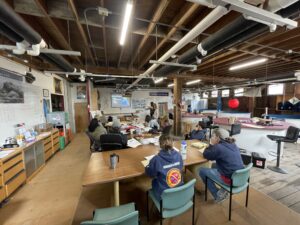
A snapshot of a classroom lecture for the Research Diving Techniques Course (Photo credit: Jason Herum)
With a 2:3 instructor-to-student ratio, we had a highly individualized learning experience. It had been months since I last took a breath while underwater and even longer since I dove in 50-degree water, so I needed a few moments for my body to adjust to the coldness seeping into my wetsuit. I wasn’t sure if I could get used to all of the restrictive layers of neoprene, especially with such thick gloves that made simple tasks cumbersome, but by the end of the week, I became much more confident in myself as a diver. My basic skills improved significantly, and I now feel a greater sense of security and assurance from having gone through rescue drills and learning to provide emergency care. We spent hours practicing CPR and using AEDs on dummies, setting up and breaking down oxygen units, and performing neurological assessments. In the water, we simulated beach and boat rescues, out-of-air scenarios, and my favorite– the ditch and don. In this exercise, we had to remove all of our gear (except our weight belts) at the bottom of the pool, turn off our tank, ascend to the surface, dive back down, turn on our tank, and put everything back on. If that sounds crazy to you, trust me, I was thinking the same thing when it was my turn. The ditching was relatively simple, but the donning was quite a struggle. I felt like I barely made it swimming back down to the 14-foot bottom without either my fins to propel me or my mask to help me navigate the otherwise blurry world. By the time I got my regulator in my mouth and opened up my tank, I was gasping. Conquering that challenge was the highlight of my day, maybe my week. On top of those emergency skills, we also hopped in the rarely-accessed Horseshoe cove to practice freediving and navigation. I had quite a lot of fun with both, but the navigation in particular was another confidence-boosting moment as my buddy and I landed fairly close to our target location in murky, surging waters.
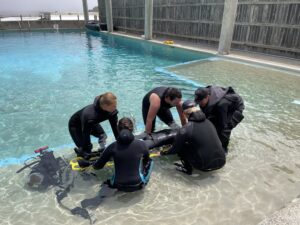
An injured diver scenario with us students in action (Photo credit: Jason Herum)
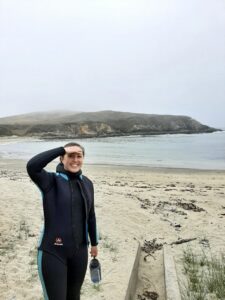
Standing in front of Horseshoe Cove and ready to freedive! (Photo credit: Sarah King)
The last two days of the session were dedicated to biological surveys and marine archaeology fundamentals. We simulated invertebrate transects, practiced sketching quadrats, used lift bags and redundant air sources, and performed trilateration. In addition to all of this, I was trained in using enhanced air nitrox (also called simply ‘nitrox’ or abbreviated as ‘EAN’) in which I breathe off a tank that has a higher percentage of oxygen. By the end of the first week of my internship, I obtained DAN DFA Pro certification.
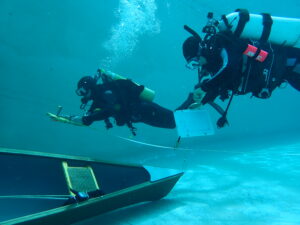
Conducting a trilateration of a sunken canoe in the Dive Training Facility with my dive buddy (left) (Photo credit: Shelby Kawana)

A group shot on the last pool session at the Diver Training Facility (Photo credit: Shelby Kawana)
During the next few weeks of my internship, I joined dive projects, helped out at the tank-filling station, and shadowed a couple of labs at BML. My first dive was a marine archaeology survey in search of an anchor in a cove off the Pacific coast, and my second dive was to help retrieve, clean, upload data from, and re-attach scientific equipment at the NOAA field station located in the San Francisco Bay (with a great view of the Golden Gate Bridge). My third dive was in the cove right off BML, in which I video-recorded two other divers repairing underwater equipment. I also got to join a boat operation to collect water quality data in Tomales Bay, and on a separate occasion I got to dive there for some underwater instrument maintenance. Back at the lab, I got to learn the basics of air compressors and filling tanks with both air and Nitrox, and was also introduced to white abalone restoration research.
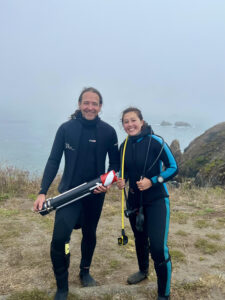
On a mission with John Harreld to GPS-tag an anchor (Photo credit: Shelby Kawana)

Cleaning a CTD instrument with a view of the Golden Gate Bridge in the distance (Photo credit: Gregg Holzer)
In mid-August, we had the second half of the research diving course. We camped along the Sonoma coast and spent five days refining the skills we learned in the pool with a greater focus on scientific diving. We performed two types of marine archaeology search techniques and conducted invertebrate transects. Our final dive was geared towards exploring a shipwreck off Fort Ross, but the visibility was so bad that we instead turned the dive into a navigation exercise back to our entry point. By completing the course, I not only obtained AAUS Scientific Diving certification, but I left with NAUI Rescue Diving and Nitrox certification as well. It only hit me after sitting down and reviewing our course schedule that I had learned so much since the first day. Without the amazingly patient, helpful, and encouraging instructors, volunteers, fellow students, and other BML staff, I wouldn’t have gotten this far.
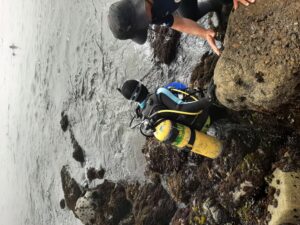
Fully geared up and entering the water at Fort Ross (Photo credit: Sarah King)

Off to do invertebrate transects with my dive buddy Will Johnson (Photo credit: Jason Herum)

Holding up my certificate of completion for the UC Davis Research Techniques course (Photo credit: Isabelle Neylan)
For the latter half of my internship, I’ll be relocating to Lake Tahoe for the entirety of September to conduct invasive species surveys alongside the UC Davis Dive Team and work with the California State Parks Dive Team on a marine archaeology project. I’ll miss all of the little charms of Bodega Bay and my adventures around this area, but I’m stoked to start the next leg of my journey. What better place than a picturesque lake to spend a month honing my scientific diving skills!

